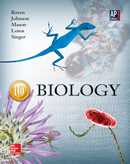1 CAL gene in Brassica oleracea . Phylogenetic analysis and CAL gene sequence analysis suggests that the stop codon appeared after the ancestors of broccoli and cauliflower diverged from the other subspecies but before broccoli and cauliflower diverged from each other. What would you predict the phenotype of broccoli to be if the stop codon had only appeared in cauliflower?A) Cannot tell. B) No different. C) It would have fewer, simple flowers. D) It would have no flowers. E) It would grow to be very large. 2 A) The human would develop wings. B) No forelimbs would develop. C) The human would develop short arms. D) The human would develop arms as normal. E) None of the above. 3 CYC gene in snapdragons and other plants is responsible for bilateral symmetry of the flower. How do you account for plants that have the CYC gene and a bilaterally symmetrical ancestor, but have radial symmetry?A) Other genes are involved that "override" the CYC gene. B) This is a mutant form of the gene that now causes radial symmetry. C) The CYC gene has lost its function. D) The CYC gene in snapdragons has mutated to code for radial symmetry. E) None of the above. 4 AP3 gene plays an important role in petal formation. Various forms of the AP3 gene were added to ap3 mutant Arabidopsis . What did this experiment conclude?A) AP3 does not play an important role in petal development.B) The 3' end of the gene has a sequence that is crucial for petal formation. C) The 5' end of the gene has a sequence that is crucial for petal formation. D) The central part of the gene has a sequence that is crucial for petal formation. E) AP3 has only a minor role in petal formation. 5 A) One mutation can completely change the function of a gene. B) There may be interaction with other genes. C) It may have become an inactive pseudogene. D) It is impossible to tell if the comparison is a derived gene. E) None of the above 6 Pax6 gene in the mouse is found almost universally in the animal kingdom and plays a role in lens formation in taxa from ribbon worms to fish. This suggests that the initiation of the eye may have evolved only once. Why is the molecular evidence more compelling than the morphological evidence?A) It is not; eyes did evolve independently. B) It has great similarity in DNA sequence among widely different organisms. C) It functions in the same role in each case. D) Transgenic experiments have shown that the Pax6 gene from different organisms are functionally equivalent. E) 2, 3 and 4. 7 A) True B) False 8 A) The same genes are used for different functions. B) Different genes are transcribed. C) The timing of gene expression varies. D) All of the above. E) None of the above. 9 A) Same for homologous, same for analogous. B) Different for homologous, different for analogous. C) Same for homologous, different for analogous. D) Different for homologous, same for analogous. E) There is no difference in the likelihoods. 10 Drosophila , particularly useful for determining the function of a gene once its sequence has been determined?A) They have well-known genomes. B) They are easy to manipulate in the laboratory. C) It is possible to create transgenic organism that express foreign genes. D) They have short life-cycles. E) All of the above 11 A) True B) False 12 A) Stem length B) Flower symmetry C) Flower petals D) Stamen development E) 3 and 4. 13 A) The control of eye development is under AP3 control. B) Morphological evidence indicates eyes evolved at least twenty times. C) Pax6 initiates fly and mouse eye development.D) Planaria do NOT use Pax6 . E) The initiation of eye development may have evolved just once. 14 A) Hox genes B) Brachyury genes C) CYC genes D) MADS box genes E) Both 1 and 4 are correct. 15 A) Genes may duplicate. B) Developmental patterns are random events. C) Several hundred genes must be mutated in order to produce developmental changes. D) Very minor changes in only a few genes can produce big developmental changes. E) Small genes can produce large changes.





